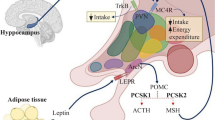Abstract
Quantitative trait locus (QTL) analysis is a statistical method that can be applied to identify loci making a significant impact on a phenotype. For the phenotype of susceptibility to diet-induced atherosclerosis in the mouse, we have studied four quantitative traits: area of aortic fatty streaks and serum concentrations of high-density lipoprotein-bound cholesterol (HDL-cholesterol), apolipoprotein A-I, and apolipoprotein A-II (apo A-II). QTL analysis revealed a significant locus on chromosome 1 distal impacting serum apo A-II concentration on a high-fat diet and serum HDL-cholesterol concentration on a chow diet. This locus is presumablyApoa-2, the structural gene for apo A-II. QTL analysis of aortic fatty streaks failed to reveal a significant locus.
Similar content being viewed by others
References
Bachorik, P. S., and Albers, J. J. (1986). Precipitation methods for quantification of lipoproteins.Meth. Enzymol. 12978.
Breckenridge, W. C., Roberts, A., and Kuksis, A. (1985). Lipoprotein levels in genetically selected mice with increased susceptibility to atherosclerosis.Arteriosclerosis 5256.
LeBoeuf, R. C., Puppione, D. L., Schumaker, V. N., and Lusis, A. J. (1983). Genetic control of lipid transport in mice. I. Structural properties and polymorphisms of plasma lipoproteins.J. Biol. Chem. 2585071.
LeBoeuf, R. C., Doolittle, M. N., Montcalm, A., Martin, D. C., Reue, K., and Lusis, A. J. (1990). Phenotypic characterization of theAth-1 gene controlling high density lipoprotein levels and susceptibility to atherosclerosis.J. Lipid Res. 3191.
Lusis, A. J., Taylor, B. A., Wangenstein, R. W., and LeBoeuf, R. C. (1983). Genetic control of lipid transport in mice. II. Genes controlling structure of high density lipoprotein.J. Biol. Chem. 2585071.
Manly, K., and Elliott, R. (1991). RI manager, a microcomputer program for analysis of data from recombinant inbred strains.Mammal. Genome 1123.
Mehrabian, M., Qiao, J.-H., Hyman, R., Ruddle, D., Laughton, C., and Lusis, A. J. (1993). Genetic loci controlling high density lipoprotein levels in mice: Role of apolipoprotein A-II andAth-1 genes.Arteriosclerosis 131.
Paigen, B., Morrow, A., Brandon, C., Mitchell, D., and Holmes, P. (1985). Variation in susceptibility to atherosclerosis among inbred strains of mice.Atherosclerosis 5765.
Paigen, B., Albee, D., Holmes, P., and Mitchell, D. (1987a). Genetic analysis of murine strains C57BL/6J and C3H/HeJ to confirm the map position ofAth-1, a gene determining atherosclerosis susceptibility.Biochem. Genet. 25501.
Paigen, B., Mitchell, D., Reue, K., Morrow, A., Lusis, A. J., and LeBoeuf, R. C. (1987b).Ath-1, a gene determining atherosclerosis susceptibility and high density lipoprotein levels in mice.Proc. Natl. Acad. Sci. USA 873763.
Paigen, B., Morrow, A., Holmes, P., Mitchell, D., and Williams, R. (1987c). Quantitative assessment of atherosclerotic lesions in mice.Atherosclerosis 68231.
Paigen, B., Ishida, B., Verstuyft, J., Winters, R., and Albee, D. (1990). Atherosclerosis susceptibility differences among progenitors of recombinant inbred strains of mice.Atherosclerosis 10316.
Paterson, A., Lander, E., Hewitt, J., Peterson, S., Lincoln, S., and Tanksley, S. (1988). Resolution of quantitative traits into Mendelian factors by using a complete linkage map of restriction fragment length polymorphisms.Nature (London) 335721.
Qiao, J.-H., Castellani, L., Fishbein, M., and Lusis, A. J. (1993a). Immune complex-medicated vasculitis increases coronary lipid accumulation in autoimmune-prone MRL mice.Arterioscler. Thromb. 13932.
Qiao, J.-H., Welch, C., Xie, P.-Z., Fishbein, M., and Lusis, A. J. (1993b). Involvement of the tyrosinase gene on the deposition of cardiac lipofuscin in mice.J. Clin. Invest. 922386.
Steinberg, D. (1986). Lipoproteins and atherogenesis: Current concepts. In Hallgren, B., Levin, O., Rossner, A., and Vessby, B. (eds.),Diet and Prevention of Coronary heart disease Raven Press, New York, 1986, pp. 95–111.
Stewart-Phillips, J., Lough, J., and Skamene, E. (1989).Ath-3, a new gene for atherosclerosis in the mouse.Clin Invest. Med. 12121.
Taylor, B. (1990). Recombinant inbred strains. In Lyon, M. F., and Searle, A. G. (eds.),Genetic Variants and Strains of the Laboratory Mouse Oxford University Press, Oxford, pp. 773–796.
Warnick, G. R. (1986). Enzymatic methods for quantitation of lipoprotein lipids.Meth. Enzymol. 129101.
Author information
Authors and Affiliations
Rights and permissions
About this article
Cite this article
Hyman, R.W., Frank, S., Warden, C.H. et al. Quantitative trait locus analysis of susceptibility to diet-induced atherosclerosis in recombinant inbred mice. Biochem Genet 32, 397–407 (1994). https://doi.org/10.1007/BF00566060
Received:
Revised:
Issue Date:
DOI: https://doi.org/10.1007/BF00566060




